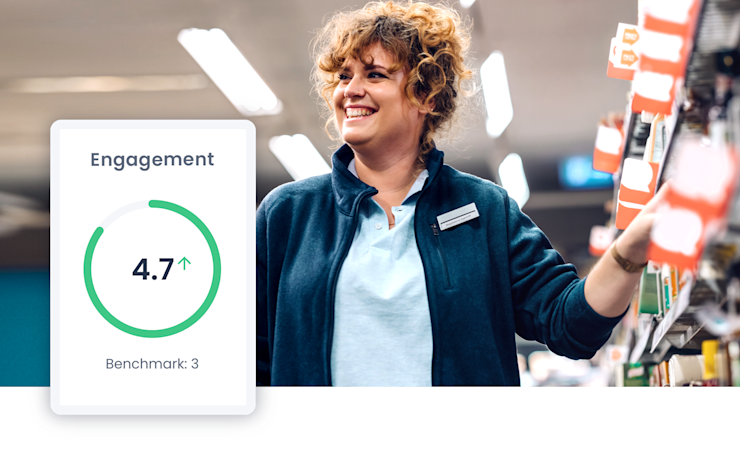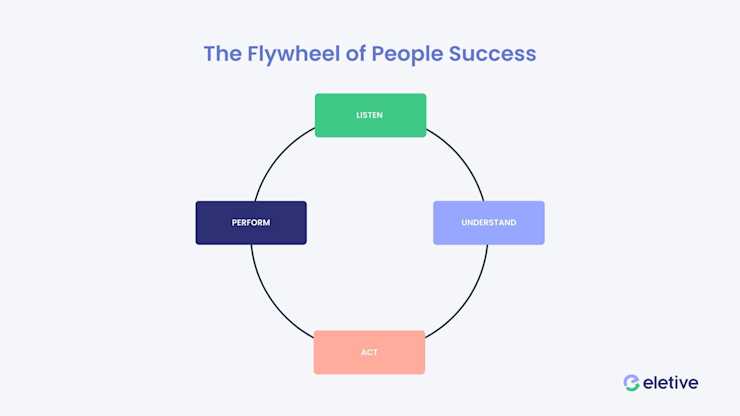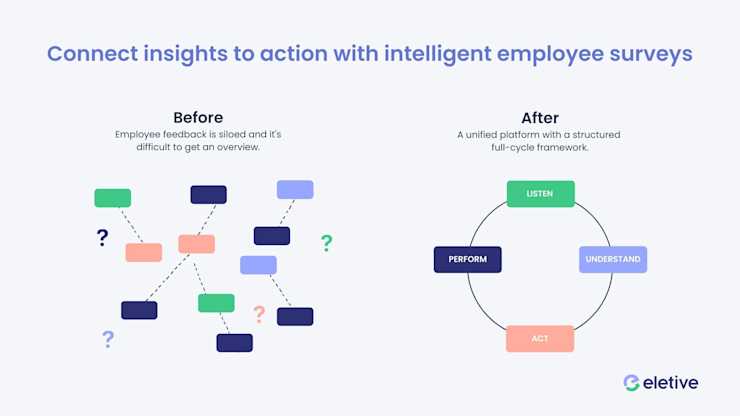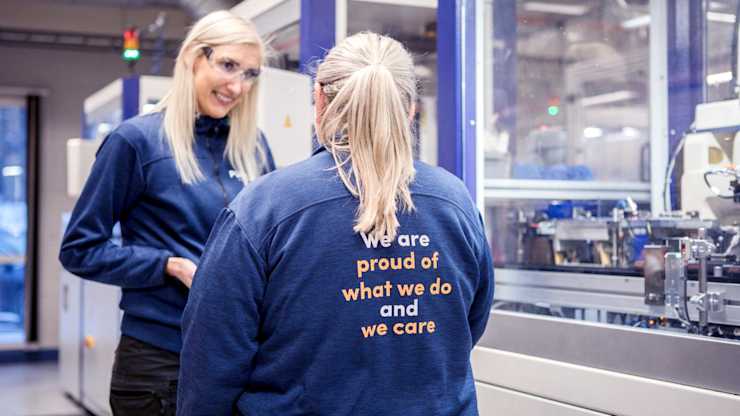A positive employee experience leads to individual satisfaction and organisational success. Join us as we uncover the key elements of a great employee experience and discover why it matters in 2023.
As we navigate the digital age and the rise of remote work, investing in exceptional digital employee experiences has become crucial.
A positive employee experience leads to individual satisfaction and organisational success. The benefits are higher engagement, productivity, retention rates, and customer satisfaction scores. In this blogpost we will uncover what the employee experience is and how you can measure it.
What is employee experience? (definition)
Employee experience (EX) is the sum of all interactions an employee has with their employer.
It includes everything from the company culture and physical workspace to the technology and tools used in daily work.
A positive employee experience with these touchpoints leads to individual satisfaction and organisational success.
Gallup's research reveals that when employees are motivated which is highly connected to their employee experience, their work quality improves significantly, resulting in a noteworthy 23% increase in the company's growth and financial success.
In today's digital age, where remote work is becoming more common, it's crucial for companies to invest in creating exceptional digital employee experiences.

Employee experience vs employee engagement: what's the difference?
There are many definitions of employee engagement floating around out there. This one from Engage for Success sums up the concept of employee engagement very well:
“Employee engagement is a workplace approach resulting in the right conditions for all members of an organisation to give of their best each day, committed to their organisation’s goals and values, motivated to contribute to organisational success, with an enhanced sense of their own well-being.”
A shorter version is Gallup’s definition of employee engagement:
“Engaged employees are those who are involved in, enthusiastic about, and committed to their work and workplace.”
Employee engagement, in other words, is the holy grail. It’s what makes people perform at their best, speak highly of their workplace, and provide the best possible experience for their customers.
One way of putting it is that employee experience is the input, and employee engagement is the output. A positive employee experience yields increased employee engagement. On paper, it’s a simple enough formula.
Why is employee experience important?
According to a Gallup study, companies with highly engaged employees outperform their competitors by 147% in earnings per share.
Companies that emphasise employee experience have been demonstrated to possess decreased attrition and heightened customer contentment.
Jacob Morgan studied 250 companies and found top employee experience companies demonstrate strong ROI across three key areas: increased industry recognition, improved business metrics (despite being smaller), and superior stock price performance.
Fostering engagement and establishing a pleasant atmosphere can yield noteworthy advantages for businesses.
Organisations can strive to create a more open atmosphere where workers feel respected and inspired to give their all.
As Richard Branson once said in a famous employee engagement quote… "Clients do not come first. Employees come first."
Calculate your ROI of employee engagement
The benefits of investing in employee experience
Creating a positive employee experience has an impact on a number of areas:
Increased employee engagement. A better experience means a higher level of engagement.
Improved employee retention. A positive experience will make people more inclined to stay longer.
Reduced absenteeism. An improved experience will reduce sick leave and burnout.
Increased productivity. A better experience and more engaged employees means improved productivity.
A stronger employer brand. Happy employees are the best ambassadors and will help you attract top talent.
Increased revenue. Engaged employees create better customer experiences and help grow your business.
How employee experience impacts customer experience
EX is directly linked to business performance and business outcomes. The reason for this is that customer experience is directly related to employee experience. Sometimes investing in your culture and work environment can actually be the quickest way to affect your bottom line. One report by IBM and Globoforce showed a strong correlation between improved employee experiences and improved key performance outcomes.
Research tells us that companies that excel at providing outstanding customer experience have 1.5 times more engaged employees than companies providing bad customer experiences. Investing in and focusing on employee experience has a direct impact on the bottom line.
Happy employees go above and beyond in their roles, resulting in better service for customers.

Employee experience model
An effective employee experience model helps organisations create a positive work environment that fosters engagement, productivity, and satisfaction.
One popular framework is Jacob Morgan's Employee Experience Model, which focuses on three key elements:
Cultural Environment: This includes the company's values, leadership style, and organisational structure. A strong culture promotes trust, collaboration, and inclusivity.
Physical Environment: The workspace design and layout can impact employees' well-being and performance. Factors like posture, illumination and climate regulation are fundamental for a pleasing work environment.
Technological Environment: Providing employees with modern tools and technology enables them to perform their tasks efficiently while promoting innovation.
In addition to these dimensions of employee experience models, Gallup's Q12 survey measures factors such as role clarity and recognition systems, offering valuable insights into areas that need improvement.
To enhance your organisation's employee experience model, consider adopting best practices from successful companies like Google or Zappos who prioritise employee happiness by creating supportive environments where individuals feel valued and empowered to contribute their best work.
Employee experience strategy
To create a great employee experience you should consider the following first: culture, work environment, tech tools, and growth opportunities.
Once you’ve done that, here are some practical tips and best practices when creating your strategy:
Align with organisational goals: Ensure that your employee experience initiatives align with your company's mission, vision, and values. This helps create a cohesive culture where employees feel connected to the organisation.
Create a feedback loop: Encourage open communication by implementing regular employee engagement surveys, focus groups, or one-on-one meetings to gather insights on what matters most to your workforce.
Prioritise well-being: Promote physical, mental, and emotional well-being through wellness programs, flexible working arrangements, and supportive policies.
Inclusive leadership: Foster an inclusive environment by promoting diversity in leadership positions and encouraging leaders to be empathetic listeners who value diverse perspectives.
Leverage technology: Utilise digital tools like Eletive's platform for measuring engagement levels while also offering personalised development opportunities based on individual needs.
Taking these steps can help you develop a comprehensive employee experience strategy that not only enhances satisfaction but also drives business results by attracting top talent and retaining high-performing employees.

How to measure and improve the employee experience
So you’ve implemented your strategy, now you need to measure it.
A straightforward way to measure EX is the employee net promoter score (ENPS). ENPS surveys are based on one single question: how likely is your employee is to recommend your company as a good place to work. A higher score indicates happier and more engaged employees and a positive employee experience.
But to get the full picture and really understand how your employees perceive their work environment, the best tool is regular employee engagement surveys.
Regular pulse surveys allow you to monitor the employee experience and level of engagement in real-time. You can also use targeted employee surveys to get insights about specific touchpoints and stages in the employee lifecycle, for example, with onboarding surveys and offboarding surveys.
Understanding employee experience surveys
An employee experience survey is a tool used by organisations to measure and understand their employees' perceptions, feelings, and experiences in the workplace.
Employees' perceptions, feelings, and experiences in the workplace can be gleaned from an employee experience survey which provides insights into job satisfaction, work-life balance, professional development opportunities, and overall engagement levels.
The key components of an effective employee experience survey
Well-crafted questions: Clear and concise questions that cover all relevant aspects of the employee experience are crucial for obtaining accurate feedback.
Anonymity: Ensuring confidentiality encourages honest feedback from employees without fear of repercussions.
Data analysis: Gathering actionable insights from the data collected is essential for identifying areas for improvement or reinforcement.
Follow-up actions: Implementing changes based on survey results demonstrates commitment to improving the employee experience.
Conducting regular surveys helps organisations track progress over time and adapt their strategies accordingly.
Factors to consider when choosing an employee experience management platform
Ease of use: The platform should be user-friendly for both employees providing feedback and administrators managing the process.
Data security: Ensure that your chosen solution adheres to strict privacy standards while handling sensitive employee information.
Customization options: Look for a tool that allows you to tailor surveys or questionnaires according to your organisation's unique needs.
Actionable insights: A robust analytics engine should enable you to identify trends and areas requiring improvement quickly.
Functionality: Look for a platform that offers a comprehensive suite of features, including surveys, analytics, and reporting tools.
Get our guide: From insight to action
Choosing the right platform can be crucial in driving positive change within your organisation. So, make sure to evaluate potential solutions carefully and consider the factors mentioned above.
Eletive is an innovative employee engagement platform that meets all these criteria and more.
With its powerful survey capabilities, real-time analytics, and customizable dashboards, Eletive helps organisations create positive work environments where employees thrive. To learn more about how Eletive can improve your employee experience, visit Eletive.com.

Employee experience examples
Check out these real-world examples of organisations with exceptional employee experiences. By highlighting specific initiatives, practices, and programs that contribute to a positive employee experience, you can gain valuable insights for your own organisation.
Google: Known for its innovative workplace culture and commitment to employee well-being, Google offers perks such as free meals, on-site fitness centres, and flexible work arrangements. Employees are evidently content and motivated due to the attention given to creating a pleasant work atmosphere.
Salesforce: Prioritising giving back through their philanthropic arm - the Salesforce Foundation, employees are encouraged to participate in volunteer activities during paid time off. This fosters a sense of purpose among employees while also benefiting local communities.
Purmo Group: By implementing Eletive's platform to measure and improve their employee engagement levels across multiple countries, Purmo Group saw significant improvements in overall engagement scores within just six months.

Take inspiration from these successful companies to guide your efforts towards fostering an outstanding employee experience at your organisation.
Conclusion
Employee experience is the sum of all interactions an employee has with their employer, from the first contact as a potential recruit to the last interaction after the end of employment.
It's important to note that employee experience is not the same as employee engagement, although they are related.
Improving employee experience can have a positive impact on customer experience, as happy employees are more likely to provide better customer service.
To improve employee experience, companies can conduct surveys to gather feedback and use management platforms to streamline processes.
Some companies with great employee experiences include Dole Nordic, SATS, Croisette, Purmo Group. You can join them by working with Eletive.
FAQ
What is the Impact of Employee Experience?
A strong EX leads to increased engagement, productivity, lower absenteeism, decreased attrition rates, stronger talent attraction, and a more innovative workforce.
What is the most important part of Employee Experience?
The most important part of EX is creating a supportive and inclusive workplace culture that values employees' well-being, fosters open communication, provides opportunities for growth and development, and recognizes their contributions.

Johanna is Content Manager at Eletive, where she juggles everything from blogging and social media to webinars and customer communications. She enjoys using digital marketing strategy and creative content marketing to help organisations build workplaces where people thrive.

























